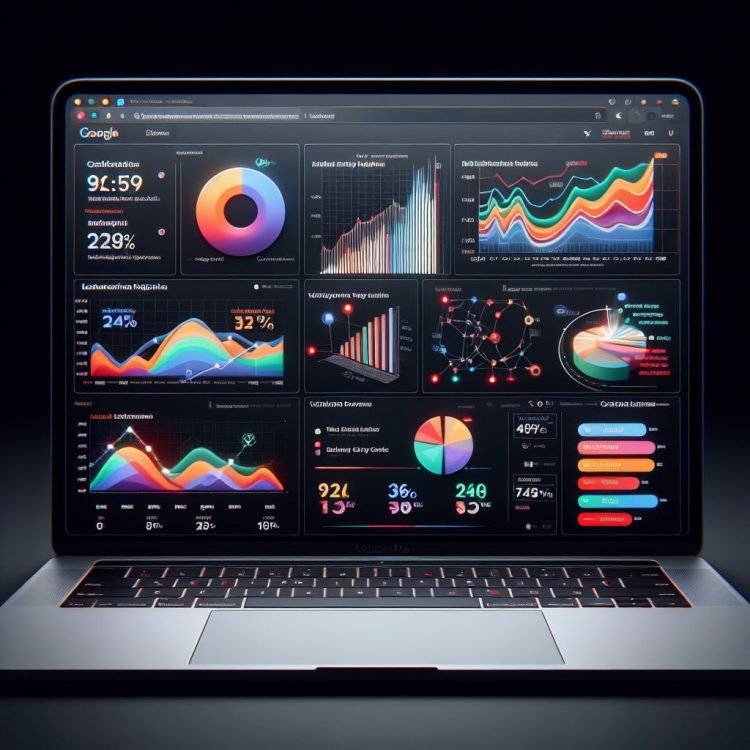In the e-commerce world of Mumbai, leveraging advanced Google Analytics techniques can provide invaluable insights and help businesses stay ahead of the competition. While many businesses use Google Analytics for basic tracking and reporting, there are several underrated techniques that can unlock a wealth of actionable data. In this blog post, we’ll explore some of these lesser-known techniques and how they can benefit e-commerce businesses in Mumbai.

What is advanced Google Analytics?
Advanced Google Analytics refers to the use of advanced features and techniques within the Google Analytics platform to gain deeper insights into website or app performance, user behaviour, and marketing effectiveness. While basic Google Analytics provides standard reports on metrics like page views, sessions, and traffic sources, advanced Google Analytics goes further by offering more sophisticated analysis tools and customization options.
1. Enhanced Ecommerce Tracking
Enhanced Ecommerce Tracking goes beyond standard e-commerce tracking in Google Analytics, providing detailed insights into the customer journey. By enabling this feature, businesses can track actions such as product impressions, clicks, adding/removing products from the cart, and completed transactions. This data can help businesses understand user behaviour, optimise their sales funnel, and improve conversion rates.
How to Implement:
Enable Enhanced Ecommerce Tracking in Google Analytics settings.
Implement tracking code on relevant pages (product pages, cart, checkout, etc.).
How Not to Implement:
Implementing tracking code incorrectly, leading to inaccurate data.
Focusing solely on tracking transactions without analyzing user behavior.
2. User ID Tracking
User ID Tracking allows businesses to track individual users across devices and sessions, providing a more holistic view of user behaviour. By assigning a unique User ID to logged-in users, businesses can track the entire customer journey, from the first interaction to the final purchase. This data can help businesses personalise their marketing efforts and improve customer retention.
How to Implement:
1. Assign a unique User ID to logged-in users.
2. Ensure User ID is persistent across devices and sessions.
How Not to Implement:
1. Using the same User ID for multiple users.
2. Not respecting user privacy preferences regarding tracking.
3. Custom Channel Groupings
Custom Channel Groupings allow businesses to create their own definitions for channels, providing a more accurate view of their marketing performance. For example, businesses can create custom groupings for different types of traffic sources, such as organic search, paid search, social media, etc. This data can help businesses understand which channels are driving the most valuable traffic and allocate their marketing budget accordingly.
How to Implement:
1. Create custom channel groupings based on business needs.
2. Regularly review and update channel groupings as needed.
How Not to Implement:
1. Creating too many custom groupings, leading to confusion.
2. Not aligning custom groupings with actual marketing channels.
4. Content Grouping
Content Grouping allows businesses to group their content into logical categories, making it easier to analyse performance. For example, an e-commerce business can group products by category, brand, or price range. This data can help businesses identify top-performing categories, optimise their product offerings, and improve user experience.
How to Implement:
1. Group content based on logical categories (e.g., product categories, blog topics).
2. Use a consistent naming convention for content groups.
How Not to Implement:
1. Grouping content too broadly, making analysis difficult.
2. Not updating content groups as new content is added.
5. Custom Alerts
Custom Alerts allow businesses to monitor their Google Analytics data for significant changes and receive alerts via email or SMS. Businesses can set up alerts for metrics such as traffic spikes, drop in conversion rates, or decrease in average order value. This proactive approach to monitoring can help businesses quickly identify and address issues before they impact their bottom line.
How to Implement:
1. Set up alerts for significant changes in key metrics.
2. Customize alerts based on business priorities and thresholds.
How Not to Implement:
1. Setting up alerts for every minor change, leading to alert fatigue.
2. Ignoring alerts or not taking action based on alert notifications.

6. Cohort Analysis
Cohort Analysis allows businesses to group users based on shared characteristics and analyse their behaviour over time. This can help businesses understand how different user segments behave and how their behaviour changes over time. For example, businesses can create cohorts based on the acquisition date and analyse how these cohorts differ in terms of retention, conversion rates, and lifetime value.
How to Implement:
1. Define cohorts based on relevant criteria (e.g., acquisition date, behavior).
2. Analyze cohort behavior over time to identify trends and patterns.
How Not to Implement:
1. Using irrelevant or inaccurate criteria for defining cohorts.
2. Not segmenting cohorts properly, leading to skewed analysis.
7. User Explorer
User Explorer provides businesses with individual-level data, allowing them to analyse the behaviour of specific users. Businesses can see the actions that each user has taken on their website, such as pages visited, time spent on site, and conversion events. This data can help businesses identify patterns in user behaviour and tailor their marketing efforts to specific user segments.
How to Implement:
1. Use User Explorer to analyze individual user behavior.
2. Identify patterns and trends among specific user segments.
How Not to Implement:
1. Relying solely on User Explorer for overall data analysis.
2. Not respecting user privacy when analyzing individual user data.
8. Custom Dimensions and Metrics
Custom Dimensions and Metrics allow businesses to track additional data points that are not available in standard Google Analytics reports. For example, businesses can track the performance of specific product categories, customer segments, or marketing campaigns. This data can provide businesses with deeper insights into their performance and help them make more informed decisions.
How to Implement:
1. Define custom dimensions and metrics based on specific business needs.
2. Implement tracking code to capture custom data points.
How Not to Implement:
1. Defining too many custom dimensions and metrics, leading to complexity.
2. Not using custom dimensions and metrics in data analysis and reporting.
9. Attribution Modelling
Attribution Modelling allows businesses to assign credit to different marketing channels based on their contribution to conversions. This can help businesses understand the impact of each marketing channel on their overall conversion rate and optimise their marketing mix accordingly. Google Analytics offers various attribution models, such as first-click attribution, last-click attribution, and linear attribution, allowing businesses to choose the model that best suits their needs.
How to Implement:
1. Choose an attribution model that aligns with business goals.
2. Analyze the impact of different marketing channels on conversion rates.
How Not to Implement:
1. Using a single attribution model without considering other factors.
2. Ignoring the nuances of different attribution models and their implications.
10. Data Import
Data Import allows businesses to import external data into Google Analytics, such as offline sales data or customer demographic data. This data can be used to enhance existing Google Analytics reports and provide businesses with a more comprehensive view of their performance. By combining online and offline data, businesses can gain a deeper understanding of their customers and improve their marketing strategies.
How to Implement:
Prepare external data for import, ensuring it is in the correct format.
Use Google Analytics Data Import feature to upload external data.
How Not to Implement:
Importing irrelevant or inaccurate external data.
Not updating imported data regularly, leading to outdated insights.
Conclusion
Incorporating these advanced Google Analytics techniques can help e-commerce businesses in Mumbai gain valuable insights into their performance, optimise their marketing efforts, and drive growth. Leveraging advanced Google Analytics techniques can provide e-commerce businesses in Mumbai with valuable insights that can drive growth and improve profitability.
By implementing techniques such as Enhanced Ecommerce Tracking, User ID Tracking, Custom Channel Groupings, Content Grouping, and Custom Alerts, businesses can gain a deeper understanding of their customers, optimise their marketing efforts, and stay ahead of the competition.
FAQs
Google Analytics is a web analytics tool that helps businesses track and analyze website traffic, user behavior, and other key metrics. For e-commerce businesses in Mumbai, Google Analytics is crucial as it provides valuable insights into customer preferences, helps optimize marketing strategies, and improves overall website performance.
Enhanced Ecommerce Tracking provides detailed insights into the customer journey, allowing businesses to track actions such as product impressions, clicks, and completed transactions. This data can help businesses understand user behavior, optimize their sales funnel, and improve conversion rates.
User ID Tracking allows businesses to track individual users across devices and sessions, providing a more holistic view of user behavior. By assigning a unique User ID to logged-in users, businesses can track the entire customer journey and personalize their marketing efforts, leading to improved customer retention.
Custom Channel Groupings allow businesses to create their own definitions for channels, providing a more accurate view of their marketing performance. By creating custom groupings for different types of traffic sources, businesses can understand which channels are driving the most valuable traffic and allocate their marketing budget accordingly.
Content Grouping allows businesses to group their content into logical categories, making it easier to analyze performance. By grouping products by category, brand, or price range, businesses can identify top-performing categories, optimize their product offerings, and improve user experience.
Custom Alerts allow businesses to monitor their Google Analytics data for significant changes and receive alerts via email or SMS. By setting up alerts for metrics such as traffic spikes or drop in conversion rates, businesses can quickly identify and address issues before they impact their bottom line.
Cohort Analysis allows businesses to group users based on shared characteristics and analyze their behavior over time. By creating cohorts based on the acquisition date, businesses can understand how different user segments behave and tailor their marketing efforts accordingly.
User Explorer provides businesses with individual-level data, allowing them to analyze the behavior of specific users. By understanding the actions that each user has taken on their website, businesses can tailor their marketing efforts to specific user segments, leading to improved personalization and customer engagement.
Custom Dimensions and Metrics allow businesses to track additional data points that are not available in standard Google Analytics reports. By tracking the performance of specific product categories, customer segments, or marketing campaigns, businesses can gain deeper insights into their performance and make more informed decisions.
Attribution Modeling allows businesses to assign credit to different marketing channels based on their contribution to conversions. By understanding the impact of each marketing channel on their overall conversion rate, businesses can optimize their marketing mix and allocate their budget more effectively.




1 Comment
Elangovan R
February 14, 2024[…] You may also be interested to read about our popular post on the following topic: 2024 Advanced Google Analytics Techniques for Mumbai E-commerce […]